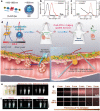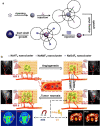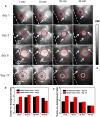Recent advances in near-infrared II imaging technology for biological detection
- PMID: 33971910
- PMCID: PMC8112043
- DOI: 10.1186/s12951-021-00870-z
Recent advances in near-infrared II imaging technology for biological detection
Abstract
Molecular imaging technology enables us to observe the physiological or pathological processes in living tissue at the molecular level to accurately diagnose diseases at an early stage. Optical imaging can be employed to achieve the dynamic monitoring of tissue and pathological processes and has promising applications in biomedicine. The traditional first near-infrared (NIR-I) window (NIR-I, range from 700 to 900 nm) imaging technique has been available for more than two decades and has been extensively utilized in clinical diagnosis, treatment and scientific research. Compared with NIR-I, the second NIR window optical imaging (NIR-II, range from 1000 to 1700 nm) technology has low autofluorescence, a high signal-to-noise ratio, a high tissue penetration depth and a large Stokes shift. Recently, this technology has attracted significant attention and has also become a heavily researched topic in biomedicine. In this study, the optical characteristics of different fluorescence nanoprobes and the latest reports regarding the application of NIR-II nanoprobes in different biological tissues will be described. Furthermore, the existing problems and future application perspectives of NIR-II optical imaging probes will also be discussed.
Keywords: Biomedical applications; Fluorescence imaging; Second near-infrared (NIR-II) window.
Conflict of interest statement
The authors have declared that no competing interests exist.
Figures







Similar articles
-
Recent advances in near-infrared I/II persistent luminescent nanoparticles for biosensing and bioimaging in cancer analysis.Anal Bioanal Chem. 2024 Jul;416(17):3887-3905. doi: 10.1007/s00216-024-05267-z. Epub 2024 Apr 9. Anal Bioanal Chem. 2024. PMID: 38592442 Free PMC article. Review.
-
Enhancing surgical outcomes: accurate identification and removal of prostate cancer with B7-H3-targeted NIR-II molecular imaging.Eur J Nucl Med Mol Imaging. 2024 Jul;51(9):2569-2582. doi: 10.1007/s00259-024-06714-w. Epub 2024 Apr 22. Eur J Nucl Med Mol Imaging. 2024. PMID: 38647671
-
3D Tumor-Mimicking Phantom Models for Assessing NIR I/II Nanoparticles in Fluorescence-Guided Surgical Interventions.ACS Nano. 2025 Jun 3;19(21):19757-19776. doi: 10.1021/acsnano.5c01919. Epub 2025 May 16. ACS Nano. 2025. PMID: 40378397
-
Responsive optical probes for deep-tissue imaging: Photoacoustics and second near-infrared fluorescence.Adv Drug Deliv Rev. 2021 Jun;173:141-163. doi: 10.1016/j.addr.2021.03.008. Epub 2021 Mar 25. Adv Drug Deliv Rev. 2021. PMID: 33774116 Review.
-
Recent Progress in Fluorescence Imaging of the Near-Infrared II Window.Chembiochem. 2018 Dec 18;19(24):2522-2541. doi: 10.1002/cbic.201800466. Epub 2018 Nov 9. Chembiochem. 2018. PMID: 30247795 Review.
Cited by
-
Two-Photon Absorption: An Open Door to the NIR-II Biological Window?Front Chem. 2022 Jun 24;10:921354. doi: 10.3389/fchem.2022.921354. eCollection 2022. Front Chem. 2022. PMID: 35815206 Free PMC article. Review.
-
Enhanced NIR-II Nanoparticle Probe for PSMA-Targeted Molecular Imaging and Prostate Cancer Diagnosis.Int J Nanomedicine. 2025 Aug 9;20:9807-9823. doi: 10.2147/IJN.S532080. eCollection 2025. Int J Nanomedicine. 2025. PMID: 40808713 Free PMC article.
-
Fluorescent Tracers for In Vivo Imaging of Lymphatic Targets.Front Pharmacol. 2022 Jul 22;13:952581. doi: 10.3389/fphar.2022.952581. eCollection 2022. Front Pharmacol. 2022. PMID: 35935839 Free PMC article. Review.
-
Organic fluorescent nanoprobes with NIR-IIb characteristics for deep learning.Exploration (Beijing). 2022 Feb 19;2(2):20210097. doi: 10.1002/EXP.20210097. eCollection 2022 Apr. Exploration (Beijing). 2022. PMID: 37323884 Free PMC article. Review.
-
NIR-II emissive AIEgen photosensitizers enable ultrasensitive imaging-guided surgery and phototherapy to fully inhibit orthotopic hepatic tumors.J Nanobiotechnology. 2021 Dec 13;19(1):419. doi: 10.1186/s12951-021-01168-w. J Nanobiotechnology. 2021. PMID: 34903233 Free PMC article.
References
Publication types
MeSH terms
Grants and funding
- 2018YFE0126900/the National key Research and Development projects intergovernmental cooperation in science and technology of China
- 82072026/the National Natural Science Foundation of China
- 81901852/the National Natural Science Foundation of China
- 2020M681902/China Postdoctoral Science Foundation funded project
- ZJ2020034/Postdoctoral Foundation of ZheJiang province
LinkOut - more resources
Full Text Sources
Other Literature Sources
Miscellaneous

